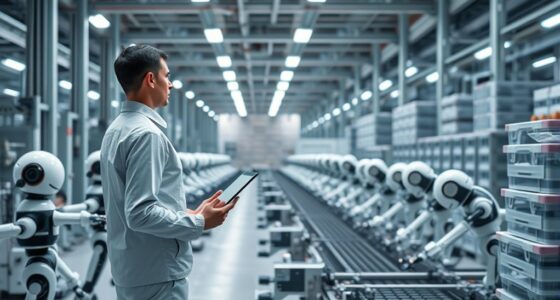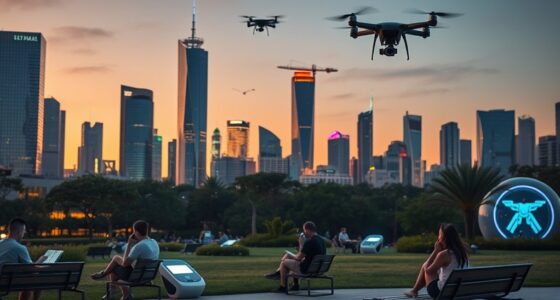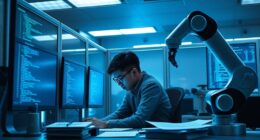Shared autonomy shifts focus from owning tools to creating seamless, adaptive human-machine partnerships that boost productivity and innovation. It combines human intentions with robot capabilities, using advanced techniques like reinforcement learning and POMDPs to improve decision-making and safety. This approach transforms workplaces by fostering trust, redistributing roles, and enabling systems to learn and adapt in real time. Exploring further will show how these innovations are shaping a future where collaboration replaces ownership entirely.
Key Takeaways
- Shared autonomy integrates human and machine decision-making, reducing reliance on ownership by enabling collaborative control of robots and systems.
- It fosters flexible, task-specific assistance, emphasizing functionality over ownership, suitable for a less work-centric, more service-oriented world.
- Advances in AI and real-time learning enhance adaptive collaboration, supporting dynamic roles without traditional ownership models.
- Organizational shifts towards continuous learning and experimentation promote shared autonomy as a means to improve productivity and innovation.
- Regulatory and safety considerations are critical to ensuring responsible deployment of shared autonomous systems beyond ownership frameworks.
Understanding Shared Autonomy and Its Foundations

Shared autonomy is a collaborative control framework where humans and autonomous systems work together to operate robotic devices. You combine your intentions with the robot’s capabilities, allowing the system to assist in tasks you find challenging or impossible alone, like steering through complex spaces. To do this effectively, the system predicts your goals, often using advanced methods like inverse optimal control, and adapts to your needs and preferences. It can take various forms, such as shared control or human-robot teaming, to achieve common objectives. This approach leverages both human intuition and robotic precision, creating a flexible, responsive partnership. The core foundations include modeling uncertainty with POMDPs, employing deep reinforcement learning, and ensuring safety through constraint-based strategies.
Key Applications Transforming Robotics and Teleoperation
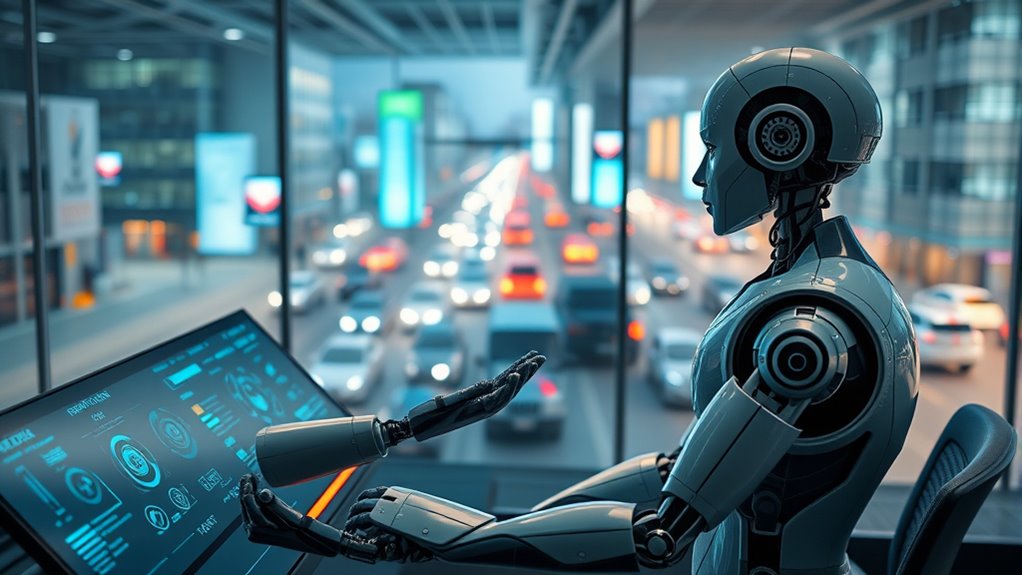
Adaptive control strategies and enhanced manipulation efficiency are driving major advances in robotics and teleoperation. These innovations allow systems to better respond to changing environments and user needs, improving performance and safety. By integrating human input with autonomous functions, you can achieve more precise, reliable, and user-friendly robotic applications. Shared autonomy enables continuous learning and adaptation, further advancing the capabilities of robotic systems in dynamic settings. Additionally, machine learning algorithms are increasingly being used to optimize autonomous decision-making processes, leading to smarter and more adaptable robotic solutions.
Adaptive Control Strategies
You are trained on data up to October 2023. Adaptive control strategies play a crucial role in enhancing the robustness and stability of teleoperation systems, particularly in environments characterized by uncertainties, communication delays, and dynamic parameter variations. These strategies enable robots to adjust their control parameters in real-time based on observed discrepancies, ensuring more accurate and reliable performance during complex tasks. The integration of adaptive control methods into teleoperation frameworks has led to significant improvements in system transparency, force tracking, and interaction stability, making them essential for applications such as remote surgery, space exploration, and underwater operations. Adaptive control strategies have demonstrated the ability to compensate for nonlinear uncertainties and external disturbances, thereby expanding the operational capabilities of robotic systems in unpredictable and dynamic scenarios. Additionally, incorporating home decor-inspired design principles can enhance the user experience by creating more intuitive and aesthetically pleasing control interfaces, ultimately improving system usability in diverse environments.
Enhanced Manipulation Efficiency
Enhanced manipulation efficiency is revolutionizing robotics and teleoperation by enabling machines to perform complex tasks with unprecedented speed and precision. Advanced actuation systems and multi-degree-of-freedom arms allow for highly accurate, repeatable motions, surpassing human consistency—crucial for applications like microscale assembly and surgery. Control systems optimize task execution, reducing time, resource waste, and errors caused by fatigue. Improved spatial understanding, through innovative models that combine visual and joint data, enhances robots’ ability to interpret 3D environments, increasing robustness in unstructured settings. Sensors and perception systems continuously evolve to provide real-time environmental data, further enhancing manipulation accuracy and system responsiveness. Additionally, remote collaboration platforms facilitate better coordination among team members across different locations, boosting overall operational efficiency. Specialized end-effectors, sensors, and control algorithms work together to ensure smooth, precise handling of delicate or hazardous materials. These technological advancements expand robots’ operational capabilities, making them more efficient, reliable, and adaptable across diverse industries.
Enhancing Workplace Productivity Through Autonomous Teams

Autonomous teams are transforming workplace productivity by empowering employees to make decisions, take ownership of their tasks, and collaborate more effectively. This boost in independence can increase productivity by up to 5.2%, while also enhancing engagement and motivation. When team members have clear roles and operate within a supportive management structure, they develop a deeper understanding of their responsibilities, leading to better performance. Reduced micromanagement allows teams to work more efficiently and adapt quickly to changing conditions. Incorporating AI tools further amplifies these benefits, with 90% of desk workers reporting higher productivity when using AI. Autonomous teams foster a culture of trust, experimentation, and learning, which improves morale and helps retain top talent in a working-less world. Additionally, understanding the emotional and spiritual states of team members through aura insights can contribute to improved interpersonal dynamics and overall team harmony.
The Benefits of Collaborative Decision-Making Systems
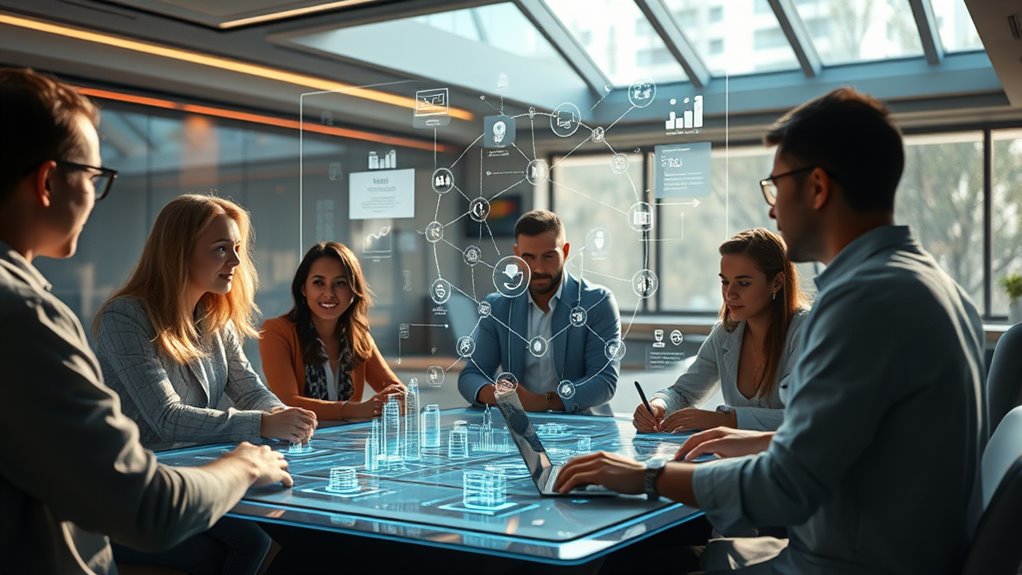
Collaborative decision-making systems unleash the full potential of team expertise by combining diverse perspectives and shared knowledge. This approach leads to better options, innovative solutions, and improved accuracy by integrating data with human insight. It also helps reduce cognitive biases through group scrutiny. When you adopt these systems, you’ll see decision outcomes improve by up to 50%. Incorporating Pimple Patch techniques can serve as a metaphor for targeted, effective interventions within team processes.
Cutting-Edge Techniques Driving Human-Machine Partnerships
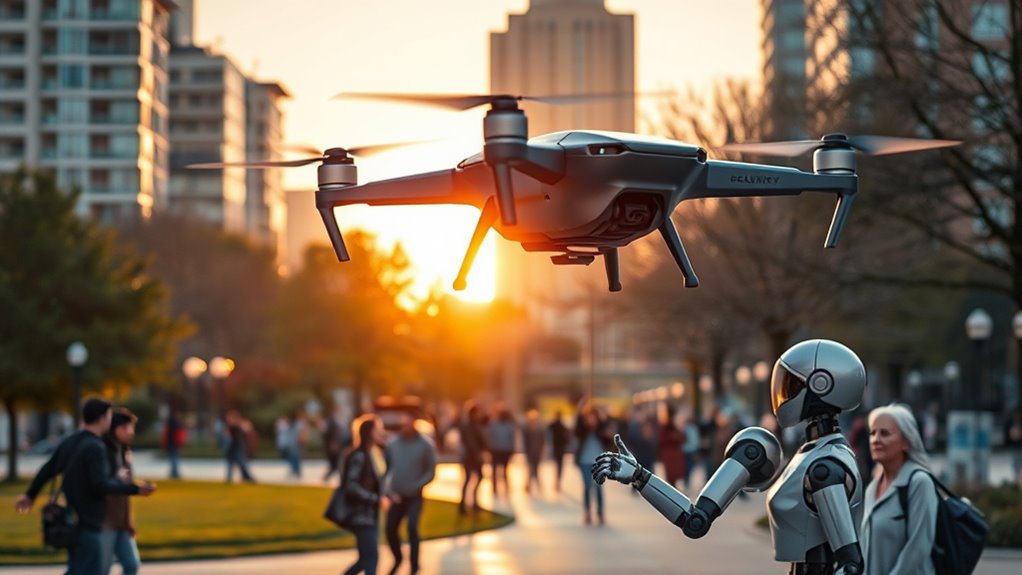
Reinforcement learning algorithms are enabling machines to adapt and improve through real-time feedback, making collaborations more intuitive. Human-centric modeling techniques focus on designing systems that prioritize human needs and behaviors, fostering trust and efficiency. Understanding the importance of virtue can guide the ethical development of these systems, ensuring they serve human well-being effectively. By integrating these cutting-edge methods, you can create more seamless and effective human-machine partnerships. Organizational culture shifts towards experimentation and continuous learning are essential to fully leverage these advanced techniques.
Reinforcement Learning Algorithms
Advances in reinforcement learning algorithms are transforming how humans and machines work together, enabling systems to learn complex behaviors efficiently and reliably. You benefit from algorithms like Proximal Policy Optimization (PPO), which smooths policy updates for better convergence, and Soft Actor-Critic (SAC), promoting stable learning of nuanced behaviors through entropy maximization. Twin Delayed Deep Deterministic Policy Gradient (TD3) reduces overestimation bias, speeding up continuous control tasks. Hierarchical Reinforcement Learning (HRL) structures tasks into subtasks, improving scalability. Recent focus on sample efficiency means fewer environment interactions, lowering costs and training times. Understanding the foundations of RL is essential for developing effective algorithms. – Better stability via experience replay and target networks – Integration with federated learning for privacy-preserving collaboration – Real-time decision-making through edge computing and 5G – Multi-agent systems enhancing cooperation and competition – Neural networks handling high-dimensional data for broader applications. Additionally, sample efficiency techniques are increasingly important for reducing the data requirements of RL systems, making them more practical for real-world deployment.
Human-Centric Modeling Techniques
Recent developments in modeling human behavior are reshaping how machines support and collaborate with people. By embedding human actions into latent task distributions, you enable robots to learn personalized assistive policies that adapt to individual users. These models recognize familiar tasks and help with them, while deferring novel actions to you, fostering trust and efficiency. Biosignal-driven control maps your EEG or EMG signals to adaptive policies, allowing real-time interpretation of your intent through Bayesian inference and deep learning. Incorporating human-centered AI principles, these techniques address cognitive load and ethical concerns, creating intuitive and trustworthy interactions. Latent representations encode context and user intent, enabling seamless switching between autonomous control and human arbitration. Overall, these modeling techniques drive more responsive, personalized, and effective human-machine partnerships in shared autonomy systems. Advances in neural decoding and adaptive learning are further enhancing the system’s ability to interpret complex biosignals with higher accuracy and lower latency. Additionally, these approaches can help reduce cognitive load by providing more natural and efficient interfaces, making technology more accessible and less burdensome for users.
Future Directions: Learning and Adapting in Real Time
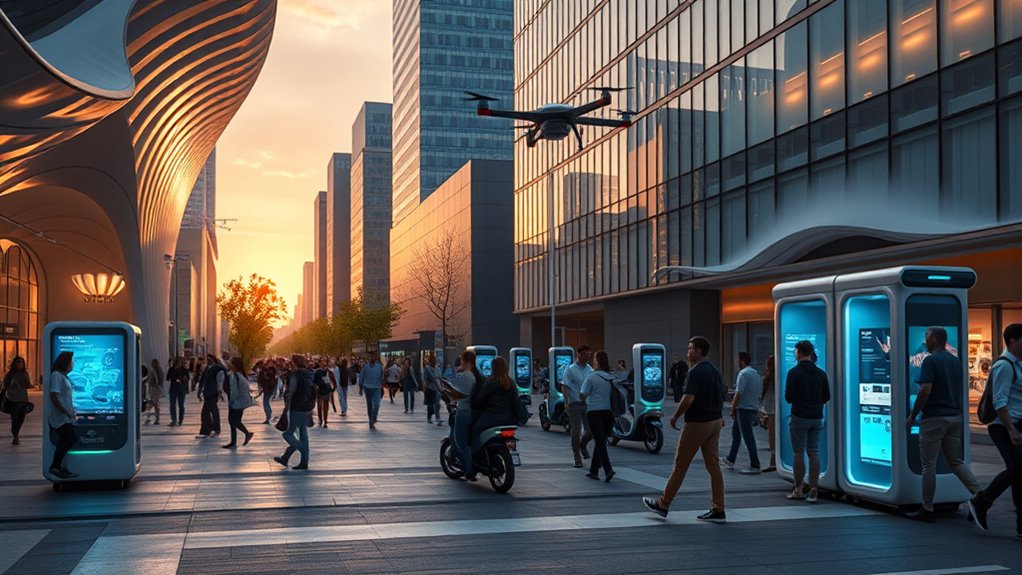
As learning technologies become more sophisticated, real-time adaptation is transforming how you acquire knowledge and skills. AI-driven systems analyze your data instantly, tailoring content, pace, and style to suit your needs. Predictive analytics identify gaps, allowing targeted interventions, while virtual tutors and AI-generated content speed up course creation and support. This continuous, just-in-time learning happens without fixed schedules or locations. To deepen this transformation:
- AI platforms personalize learning paths dynamically.
- Real-time analytics inform immediate instructional adjustments.
- Conversational interfaces enable realistic practice with AI bots.
- Immersive VR/AR environments simulate complex scenarios.
- Microlearning modules offer flexible, on-demand skill-building.
- Skills-Based Enablement Tools are critical for identifying and cultivating relevant competencies in this evolving landscape.
Together, these innovations create an adaptive ecosystem where learning is seamless, personalized, and responsive to your evolving needs.
Societal Impact: Redefining Work and Responsibility
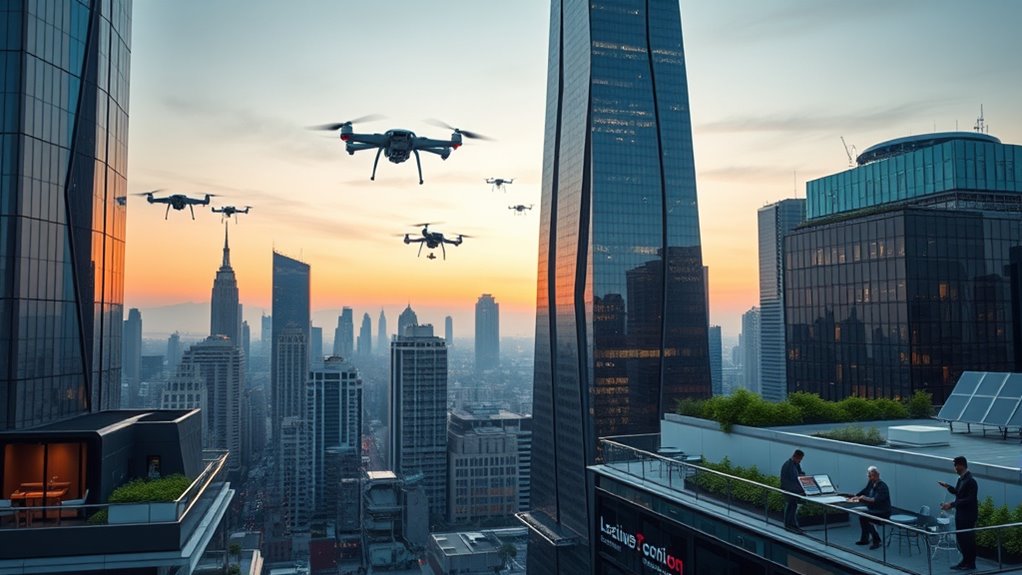
Shared autonomy technologies are reshaping the very nature of work and responsibility. You’ll find tasks redistributed between humans and machines, changing traditional roles and redefining productivity. Cultural differences influence perceptions; for example, Indian workers see autonomous desks as equally productive, while U.S. workers don’t. Human roles shift from manual tasks to supervision and strategic oversight, pushing organizations to update how they evaluate work—focusing on cognitive engagement and human-machine interaction. Responsibility becomes shared, complicating accountability; clear frameworks are essential to define decision authority and ensure transparency. As machines handle routine work, society must adapt, creating new roles like robot supervisors and system maintainers. These changes challenge existing notions of work, influence social safety nets, and prompt a rethinking of human contribution beyond traditional labor. Additionally, ongoing research in shared autonomy systems emphasizes the importance of adaptive decision-making frameworks to ensure seamless cooperation and continuous learning in dynamic environments. Recognizing the significance of workplace organization can facilitate smoother transitions and better integration of these technologies into society.
Challenges and Opportunities in Deploying Shared Autonomy
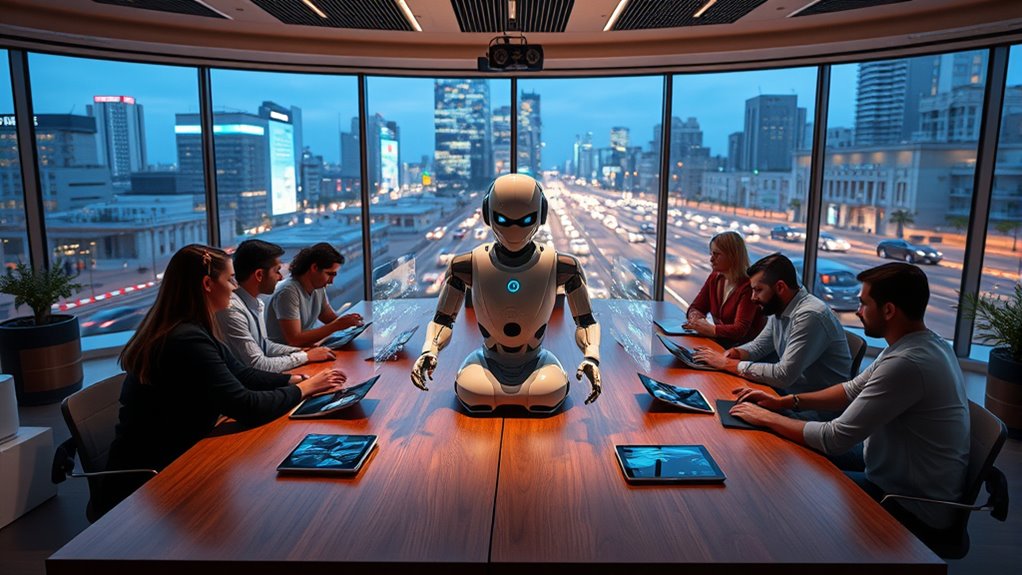
Deploying shared autonomy presents a range of challenges that organizations must carefully navigate to realize its full potential. Technological limitations, like sensing and actuation in small-scale robots, can hinder performance. Integrating these systems with existing infrastructure is complex and time-consuming. Evolving regulatory frameworks may slow innovation or impose safety constraints. User acceptance depends heavily on personalization, as everyone has unique needs. Safety remains a critical concern, requiring a careful balance of human and machine decision-making.
- Overcoming sensing and control gaps
- Streamlining system integration
- Adapting to shifting regulations
- Gaining user trust through personalization
- Ensuring safety in human-machine interactions
Envisioning a Seamless Human-Machine Collaborative Future
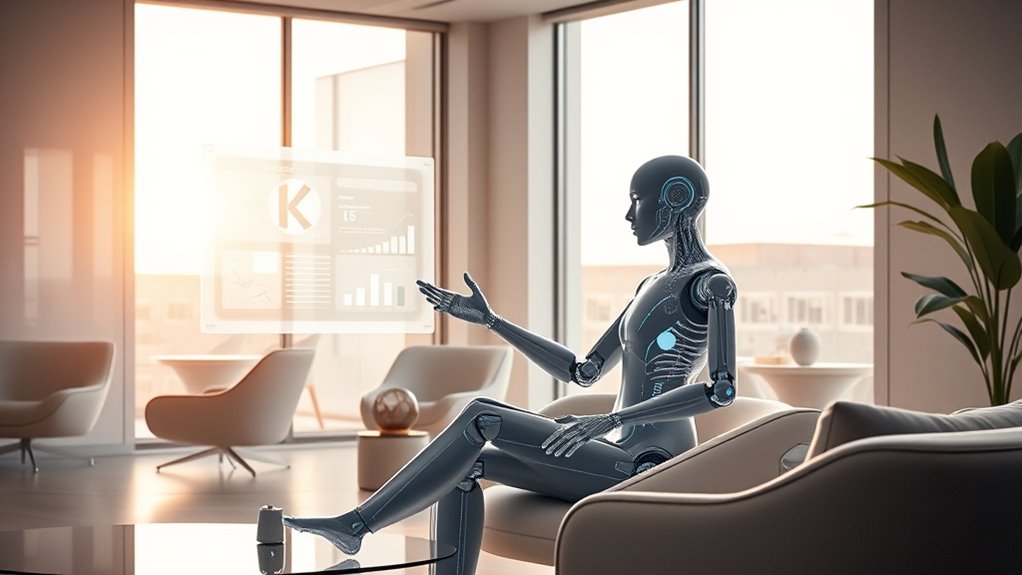
Envisioning a seamless human-machine collaborative future involves creating environments where technology enhances human capabilities without replacing them. You’ll see workplaces evolve into spaces where AI processes data and robots handle routine tasks, freeing humans to focus on empathy, ethics, and complex decision-making. As AI adoption grows, strategic investments become essential, yet many companies still grapple with implementation maturity. New skills around data governance, privacy, and AI management will be critical as cross-functional competencies develop. Technologies like AR and VR are expanding human-machine interfaces, making collaboration more intuitive. This shift promises a market valued at nearly $6 billion by 2025, expanding further by 2033. Ultimately, your role will be to leverage these tools ethically, ensuring human qualities like creativity and judgment remain central to innovation. Incorporating unique and wicked planters into workspaces can also foster creativity and well-being, promoting a more engaging environment.
Frequently Asked Questions
How Does Shared Autonomy Address Ethical Concerns in Decision-Making?
When you consider how shared autonomy addresses ethical concerns, it’s clear that involving you in decision-making guarantees your preferences are respected. It prevents paternalism by promoting collaboration and clear communication of options. This approach upholds your autonomy and aligns with ethical principles like beneficence and nonmaleficence. By actively engaging you, healthcare providers and AI systems work together to make decisions that are ethically sound, transparent, and centered on your well-being.
What Are the Privacy Implications of Shared Autonomy Systems?
Like a camera capturing every moment, shared autonomy systems collect and share personal data constantly. You might not control what’s shared or how it’s used, risking privacy breaches. Autonomous systems can transfer data to third parties or share info with other devices without your consent. This lack of transparency makes it hard to protect your privacy, especially in sensitive environments, emphasizing the need for safeguards and clear communication.
How Can Smaller Organizations Implement Shared Autonomy Effectively?
You can implement shared autonomy effectively by starting with lightweight pretraining and incremental learning, which helps adapt systems to real-world conditions with minimal data. Use expert demonstrations to refine scheduling and reduce operator workload. Personalize assistance by monitoring performance and adjusting control levels dynamically. Incorporate real-time corrections to manage task variability, focusing on small, targeted interventions. These strategies enable smaller organizations to optimize autonomous systems without significant resource investments.
What Are the Risks of Over-Reliance on Automated Assistance?
You should be aware that over-relying on automated assistance can lead to missed nuances and human judgment errors. Automation bias makes you trust AI too much, even when it’s wrong, which hampers decision-making. It also introduces vulnerabilities, as complex systems can break or hide threats. Plus, data overload can overwhelm your team, divert resources, and reduce your organization’s ability to respond effectively without critical human oversight.
How Does Shared Autonomy Impact Human Employment and Skill Development?
You might find that shared autonomy changes your employment by shifting roles toward managerial and creative tasks, giving you more control. It can boost your skill development by encouraging proactive learning, decision-making, and problem-solving. Autonomy increases your engagement and trust, making work more meaningful and satisfying. However, without proper accountability, too much autonomy could lead to reduced motivation and risks of counterproductive behaviors, so balance is essential for long-term growth.
Conclusion
So, imagine a world where robots sip coffee while you nap, making decisions faster than you can say “autonomy.” Shared autonomy isn’t just about machines taking over; it’s about teaming up—like a sitcom duo with perfect chemistry. As we ditch ownership for seamless collaboration, you’ll wonder how you ever worked alone. Embrace the future, where humans and machines dance in perfect sync—no solos allowed, just a harmonious, slightly chaotic duet.


